What Region of the Vertebral Column Does This Vertebra Belong to?
Axial Skeleton
The Vertebral Column
Learning Objectives
By the end of this section, you lot will be able to:
- Depict each region of the vertebral cavalcade and the number of bones in each region
- Hash out the curves of the vertebral column and how these change after birth
- Describe a typical vertebra and decide the distinguishing characteristics for vertebrae in each vertebral region and features of the sacrum and the coccyx
- Define the structure of an intervertebral disc
- Determine the location of the ligaments that provide support for the vertebral cavalcade
The vertebral column is also known as the spinal column or spine ((Effigy)). It consists of a sequence of vertebrae (singular = vertebra), each of which is separated and united by an intervertebral disc. Together, the vertebrae and intervertebral discs form the vertebral column. It is a flexible column that supports the caput, cervix, and body and allows for their movements. It likewise protects the spinal cord, which passes downward the back through openings in the vertebrae.
Vertebral Column
The developed vertebral column consists of 24 vertebrae, plus the sacrum and coccyx. The vertebrae are divided into 3 regions: cervical C1–C7 vertebrae, thoracic T1–T12 vertebrae, and lumbar L1–L5 vertebrae. The vertebral column is curved, with 2 chief curvatures (thoracic and sacrococcygeal curves) and 2 secondary curvatures (cervical and lumbar curves).

Regions of the Vertebral Column
The vertebral cavalcade originally develops as a series of 33 vertebrae, but this number is eventually reduced to 24 vertebrae, plus the sacrum and coccyx. The vertebral column is subdivided into v regions, with the vertebrae in each surface area named for that region and numbered in descending order. In the neck, there are seven cervical vertebrae, each designated with the letter "C" followed by its number. Superiorly, the C1 vertebra articulates (forms a joint) with the occipital condyles of the skull. Inferiorly, C1 articulates with the C2 vertebra, and and then on. Below these are the 12 thoracic vertebrae, designated T1–T12. The lower dorsum contains the L1–L5 lumbar vertebrae. The single sacrum, which is also role of the pelvis, is formed by the fusion of five sacral vertebrae. Similarly, the coccyx, or tailbone, results from the fusion of four small coccygeal vertebrae. However, the sacral and coccygeal fusions practise non start until age twenty and are not completed until middle historic period.
An interesting anatomical fact is that almost all mammals take seven cervical vertebrae, regardless of body size. This ways that there are big variations in the size of cervical vertebrae, ranging from the very minor cervical vertebrae of a shrew to the greatly elongated vertebrae in the cervix of a giraffe. In a full-grown giraffe, each cervical vertebra is eleven inches tall.
Curvatures of the Vertebral Column
The adult vertebral column does not form a straight line, but instead has four curvatures along its length (see (Effigy)). These curves increase the vertebral column'southward strength, flexibility, and power to blot shock. When the load on the spine is increased, by carrying a heavy backpack for example, the curvatures increase in depth (get more than curved) to suit the actress weight. They so leap back when the weight is removed. The iv developed curvatures are classified as either primary or secondary curvatures. Primary curves are retained from the original fetal curvature, while secondary curvatures develop afterwards birth.
During fetal development, the body is flexed anteriorly into the fetal position, giving the unabridged vertebral column a single curvature that is concave anteriorly. In the adult, this fetal curvature is retained in two regions of the vertebral cavalcade as the thoracic bend, which involves the thoracic vertebrae, and the sacrococcygeal curve, formed past the sacrum and coccyx. Each of these is thus called a main curve because they are retained from the original fetal curvature of the vertebral column.
A secondary curve develops gradually subsequently birth as the child learns to sit upright, stand, and walk. Secondary curves are concave posteriorly, contrary in direction to the original fetal curvature. The cervical curve of the cervix region develops as the infant begins to hold their head upright when sitting. Later, as the kid begins to stand up and and then to walk, the lumbar curve of the lower back develops. In adults, the lumbar bend is mostly deeper in females.
Disorders associated with the curvature of the spine include kyphosis (an excessive posterior curvature of the thoracic region), lordosis (an excessive anterior curvature of the lumbar region), and scoliosis (an abnormal, lateral curvature, accompanied past twisting of the vertebral cavalcade).
Disorders of the…
Vertebral Cavalcade Developmental anomalies, pathological changes, or obesity can enhance the normal vertebral column curves, resulting in the development of aberrant or excessive curvatures ((Effigy)). Kyphosis, besides referred to as humpback or hunchback, is an excessive posterior curvature of the thoracic region. This tin develop when osteoporosis causes weakening and erosion of the anterior portions of the upper thoracic vertebrae, resulting in their gradual collapse ((Figure)). Lordosis, or swayback, is an excessive anterior curvature of the lumbar region and is about commonly associated with obesity or late pregnancy. The accumulation of body weight in the intestinal region results an anterior shift in the line of gravity that carries the weight of the body. This causes in an anterior tilt of the pelvis and a pronounced enhancement of the lumbar curve.
Scoliosis is an abnormal, lateral curvature, accompanied by twisting of the vertebral column. Compensatory curves may also develop in other areas of the vertebral column to help maintain the caput positioned over the anxiety. Scoliosis is the most common vertebral aberration among girls. The crusade is ordinarily unknown, simply it may effect from weakness of the back muscles, defects such as differential growth rates in the correct and left sides of the vertebral cavalcade, or differences in the length of the lower limbs. When nowadays, scoliosis tends to become worse during adolescent growth spurts. Although near individuals practice not crave treatment, a back caryatid may be recommended for growing children. In farthermost cases, surgery may be required.
Excessive vertebral curves can be identified while an individual stands in the anatomical position. Observe the vertebral profile from the side so from behind to cheque for kyphosis or lordosis. So have the person curve forward. If scoliosis is present, an private will have difficulty in angle straight forward, and the right and left sides of the back will non be level with each other in the aptitude position.
Abnormal Curvatures of the Vertebral Column
(a) Scoliosis is an abnormal lateral bending of the vertebral column. (b) An excessive curvature of the upper thoracic vertebral column is called kyphosis. (c) Lordosis is an excessive curvature in the lumbar region of the vertebral column.
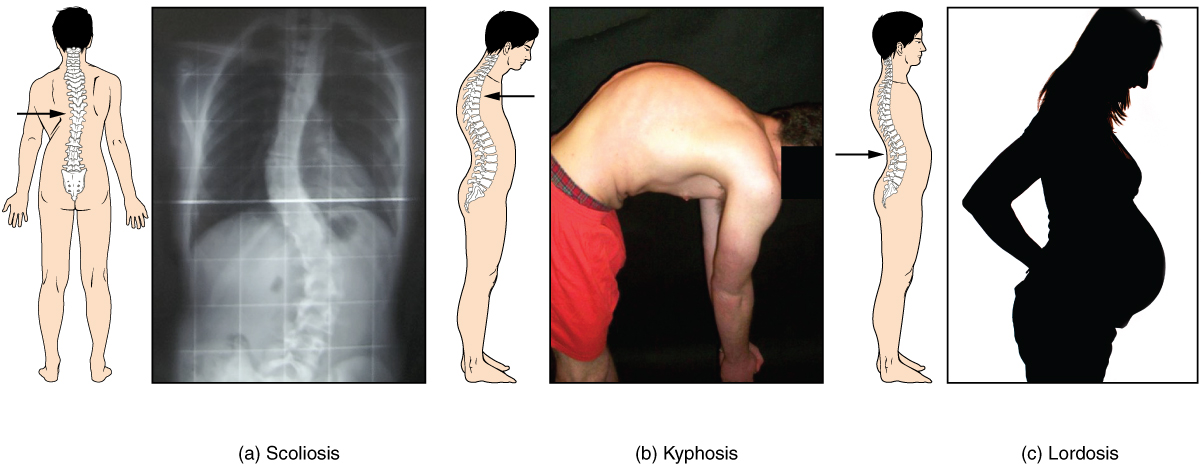
Osteoporosis
Osteoporosis is an age-related disorder that causes the gradual loss of bone density and strength. When the thoracic vertebrae are affected, there can be a gradual collapse of the vertebrae. This results in kyphosis, an excessive curvature of the thoracic region.
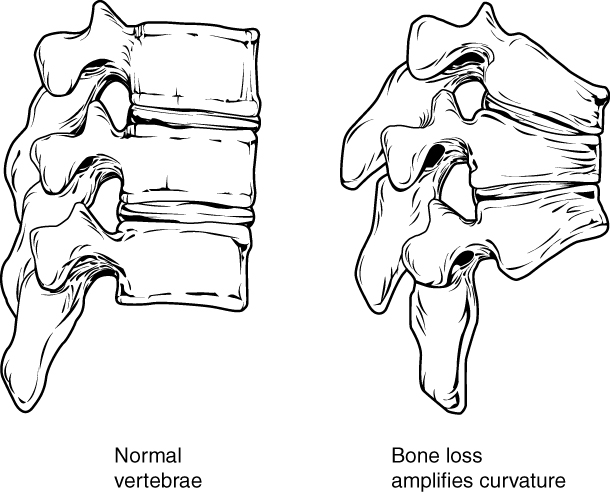
Osteoporosis is a mutual historic period-related bone disease in which bone density and strength is decreased. Watch this video to go a better agreement of how thoracic vertebrae may get weakened and may fracture due to this disease. How may vertebral osteoporosis contribute to kyphosis?
General Structure of a Vertebra
Within the dissimilar regions of the vertebral column, vertebrae vary in size and shape, but they all follow a similar structural blueprint. A typical vertebra will consist of a torso, a vertebral arch, and seven processes ((Effigy)).
The body is the anterior portion of each vertebra and is the part that supports the body weight. Because of this, the vertebral bodies progressively increase in size and thickness going down the vertebral column. The bodies of next vertebrae are separated and strongly united past an intervertebral disc.
The vertebral arch forms the posterior portion of each vertebra. It consists of 4 parts, the right and left pedicles and the correct and left laminae. Each pedicle forms one of the lateral sides of the vertebral arch. The pedicles are anchored to the posterior side of the vertebral body. Each lamina forms office of the posterior roof of the vertebral arch. The large opening betwixt the vertebral curvation and body is the vertebral foramen, which contains the spinal cord. In the intact vertebral column, the vertebral foramina of all of the vertebrae align to form the vertebral (spinal) canal, which serves as the bony protection and passageway for the spinal cord downwardly the dorsum. When the vertebrae are aligned together in the vertebral cavalcade, notches in the margins of the pedicles of adjacent vertebrae together form an intervertebral foramen, the opening through which a spinal nerve exits from the vertebral cavalcade ((Figure)).
Seven processes ascend from the vertebral arch. Each paired transverse process projects laterally and arises from the junction point between the pedicle and lamina. The single spinous process (vertebral spine) projects posteriorly at the midline of the back. The vertebral spines tin can easily exist felt as a serial of bumps just under the skin down the middle of the back. The transverse and spinous processes serve every bit important muscle attachment sites. A superior articular process extends or faces upward, and an inferior articular process faces or projects downwards on each side of a vertebrae. The paired superior articular processes of one vertebra bring together with the corresponding paired inferior articular processes from the next higher vertebra. These junctions class slightly moveable joints between the adjacent vertebrae. The shape and orientation of the articular processes vary in different regions of the vertebral cavalcade and play a major role in determining the type and range of motion available in each region.
Parts of a Typical Vertebra
A typical vertebra consists of a body and a vertebral arch. The arch is formed past the paired pedicles and paired laminae. Arising from the vertebral curvation are the transverse, spinous, superior articular, and junior articular processes. The vertebral foramen provides for passage of the spinal cord. Each spinal nerve exits through an intervertebral foramen, located between adjacent vertebrae. Intervertebral discs unite the bodies of next vertebrae.
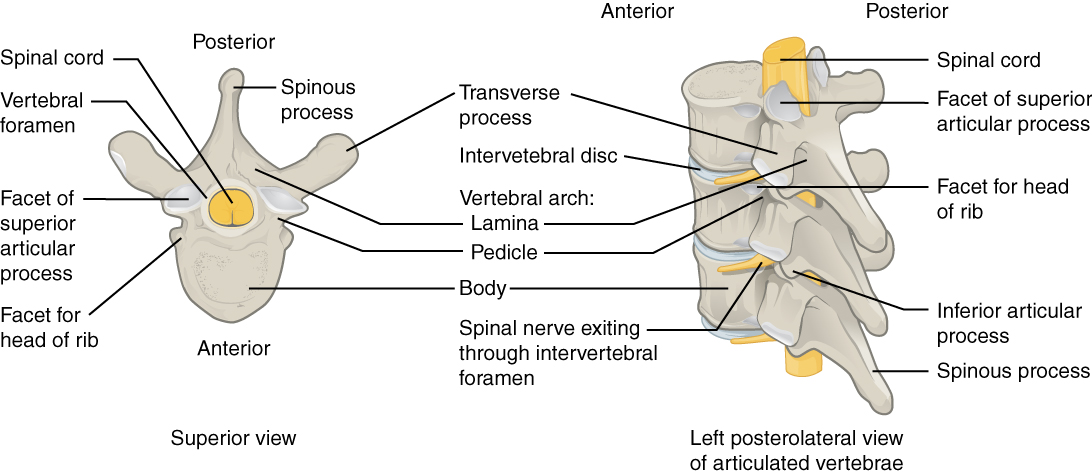
Intervertebral Disc
The bodies of adjacent vertebrae are separated and united by an intervertebral disc, which provides padding and allows for movements between adjacent vertebrae. The disc consists of a fibrous outer layer called the anulus fibrosus and a gel-similar center called the nucleus pulposus. The intervertebral foramen is the opening formed between side by side vertebrae for the exit of a spinal nervus.
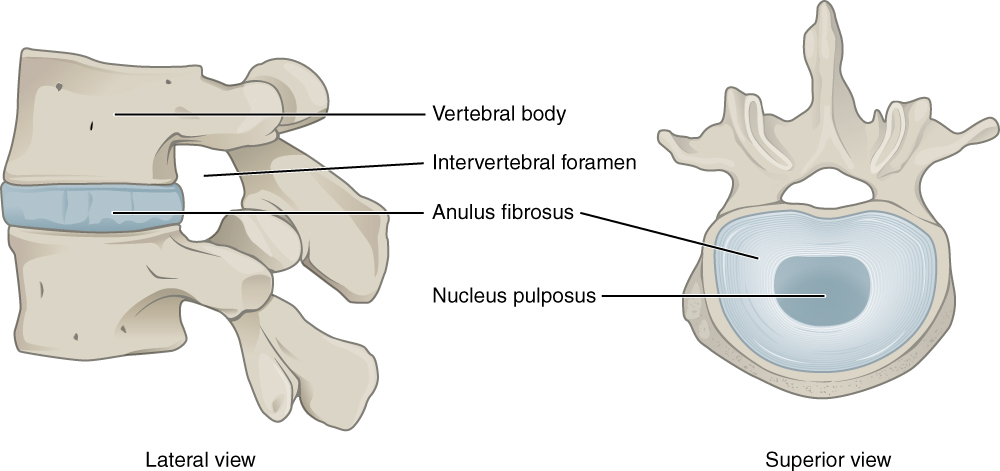
Regional Modifications of Vertebrae
In addition to the general characteristics of a typical vertebra described higher up, vertebrae likewise brandish feature size and structural features that vary between the dissimilar vertebral column regions. Thus, cervical vertebrae are smaller than lumbar vertebrae due to differences in the proportion of body weight that each supports. Thoracic vertebrae take sites for rib attachment, and the vertebrae that requite rise to the sacrum and coccyx have fused together into single bones.
Cervical Vertebrae
Typical cervical vertebrae, such as C4 or C5, accept several characteristic features that differentiate them from thoracic or lumbar vertebrae ((Figure)). Cervical vertebrae accept a small body, reflecting the fact that they comport the least amount of body weight. Cervical vertebrae usually have a bifid (Y-shaped) barbed procedure. The spinous processes of the C3–C6 vertebrae are curt, but the spine of C7 is much longer. Yous can discover these vertebrae past running your finger downward the midline of the posterior neck until you encounter the prominent C7 spine located at the base of operations of the cervix. The transverse processes of the cervical vertebrae are sharply curved (U-shaped) to allow for passage of the cervical spinal nerves. Each transverse procedure also has an opening called the transverse foramen. An important avenue that supplies the encephalon ascends up the neck past passing through these openings. The superior and inferior articular processes of the cervical vertebrae are flattened and largely confront upward or downward, respectively.
The first and second cervical vertebrae are further modified, giving each a distinctive appearance. The first cervical (C1) vertebra is also called the atlas, because this is the vertebra that supports the skull on pinnacle of the vertebral column (in Greek mythology, Atlas was the god who supported the heavens on his shoulders). The C1 vertebra does non have a body or spinous procedure. Instead, information technology is ring-shaped, consisting of an anterior arch and a posterior arch. The transverse processes of the atlas are longer and extend more laterally than exercise the transverse processes of any other cervical vertebrae. The superior articular processes face upward and are securely curved for articulation with the occipital condyles on the base of the skull. The inferior articular processes are flat and face downwards to join with the superior articular processes of the C2 vertebra.
The 2nd cervical (C2) vertebra is chosen the axis, because it serves as the centrality for rotation when turning the caput toward the right or left. The centrality resembles typical cervical vertebrae in most respects, simply is easily distinguished past the dens (odontoid process), a bony projection that extends upward from the vertebral body. The dens joins with the inner aspect of the anterior arch of the atlas, where it is held in identify by transverse ligament.
Cervical Vertebrae
A typical cervical vertebra has a small body, a bifid barbed process, transverse processes that accept a transverse foramen and are curved for spinal nervus passage. The atlas (C1 vertebra) does not take a body or spinous process. It consists of an anterior and a posterior curvation and elongated transverse processes. The axis (C2 vertebra) has the upwards projecting dens, which articulates with the anterior arch of the atlas.
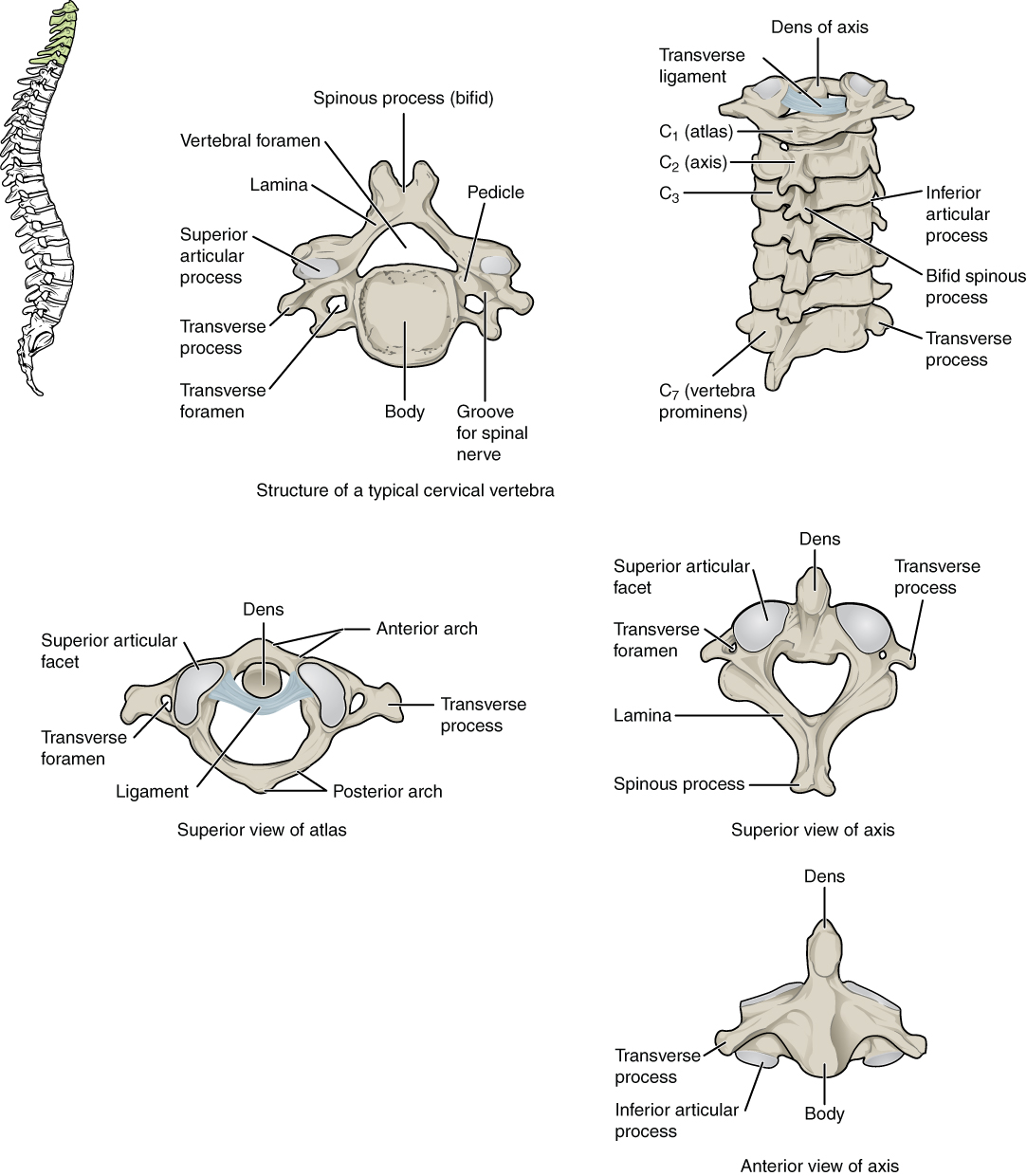
Thoracic Vertebrae
The bodies of the thoracic vertebrae are larger than those of cervical vertebrae ((Figure)). The feature characteristic for a typical midthoracic vertebra is the spinous process, which is long and has a pronounced downward angle that causes it to overlap the next inferior vertebra. The superior articular processes of thoracic vertebrae face anteriorly and the inferior processes face up posteriorly. These orientations are of import determinants for the type and range of movements bachelor to the thoracic region of the vertebral column.
Thoracic vertebrae have several additional articulation sites, each of which is called a facet, where a rib is attached. Most thoracic vertebrae have two facets located on the lateral sides of the body, each of which is called a costal facet (costal = "rib"). These are for joint with the caput (end) of a rib. An boosted facet is located on the transverse process for articulation with the tubercle of a rib.
Thoracic Vertebrae
A typical thoracic vertebra is distinguished by the barbed process, which is long and projects downward to overlap the adjacent inferior vertebra. Information technology besides has articulation sites (facets) on the vertebral trunk and a transverse process for rib attachment.
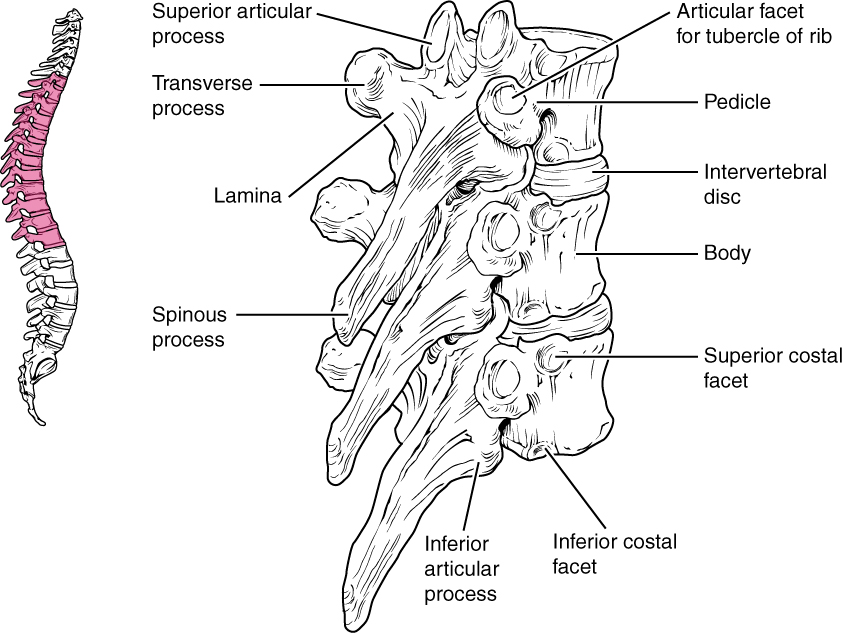
Rib Articulation in Thoracic Vertebrae
Thoracic vertebrae have superior and inferior articular facets on the vertebral body for joint with the head of a rib, and a transverse process facet for articulation with the rib tubercle.
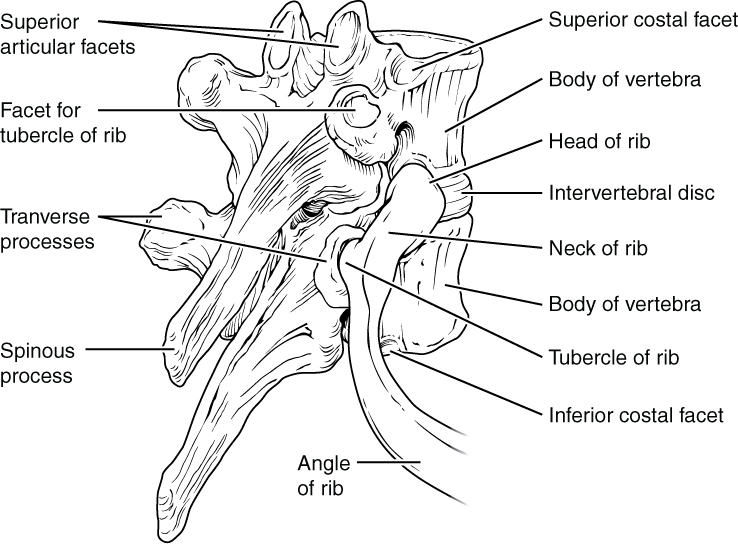
Lumbar Vertebrae
Lumbar vertebrae carry the greatest corporeality of torso weight and are thus characterized by the large size and thickness of the vertebral body ((Figure)). They accept short transverse processes and a short, blunt spinous process that projects posteriorly. The articular processes are big, with the superior process facing backward and the inferior facing forrad.
Lumbar Vertebrae
Lumbar vertebrae are characterized by having a large, thick trunk and a brusque, rounded spinous process.
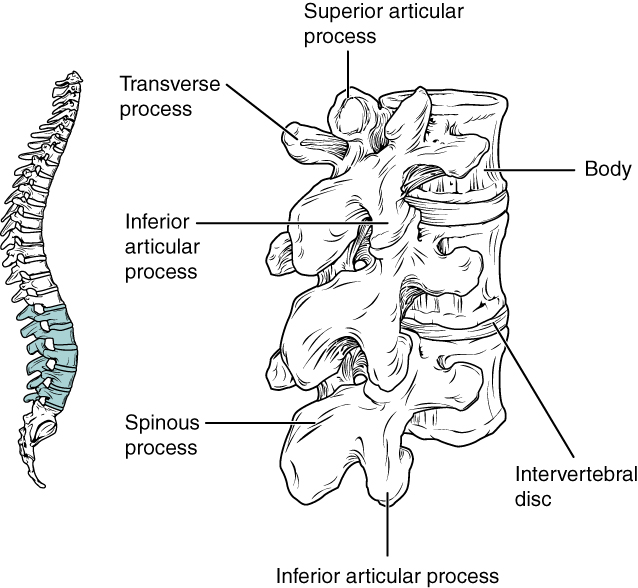
Sacrum and Coccyx
The sacrum is a triangular-shaped bone that is thick and broad across its superior base where information technology is weight bearing then tapers down to an inferior, non-weight bearing apex ((Figure)). It is formed by the fusion of five sacral vertebrae, a process that does non begin until after the age of twenty. On the inductive surface of the older developed sacrum, the lines of vertebral fusion tin exist seen as four transverse ridges. On the posterior surface, running down the midline, is the median sacral crest, a bumpy ridge that is the remnant of the fused spinous processes (median = "midline"; while medial = "toward, but not necessarily at, the midline"). Similarly, the fused transverse processes of the sacral vertebrae form the lateral sacral crest.
The sacral promontory is the anterior lip of the superior base of the sacrum. Lateral to this is the roughened auricular surface, which joins with the ilium portion of the hipbone to form the immobile sacroiliac joints of the pelvis. Passing inferiorly through the sacrum is a bony tunnel called the sacral culvert, which terminates at the sacral hiatus near the inferior tip of the sacrum. The anterior and posterior surfaces of the sacrum have a series of paired openings called sacral foramina (singular = foramen) that connect to the sacral canal. Each of these openings is called a posterior (dorsal) sacral foramen or anterior (ventral) sacral foramen. These openings allow for the anterior and posterior branches of the sacral spinal nerves to go out the sacrum. The superior articular process of the sacrum, 1 of which is found on either side of the superior opening of the sacral canal, articulates with the junior articular processes from the L5 vertebra.
The coccyx, or tailbone, is derived from the fusion of four very small coccygeal vertebrae (see (Figure)). It articulates with the inferior tip of the sacrum. Information technology is not weight bearing in the standing position, but may receive some body weight when sitting.
Sacrum and Coccyx
The sacrum is formed from the fusion of five sacral vertebrae, whose lines of fusion are indicated by the transverse ridges. The fused barbed processes course the median sacral crest, while the lateral sacral crest arises from the fused transverse processes. The coccyx is formed by the fusion of four small coccygeal vertebrae.
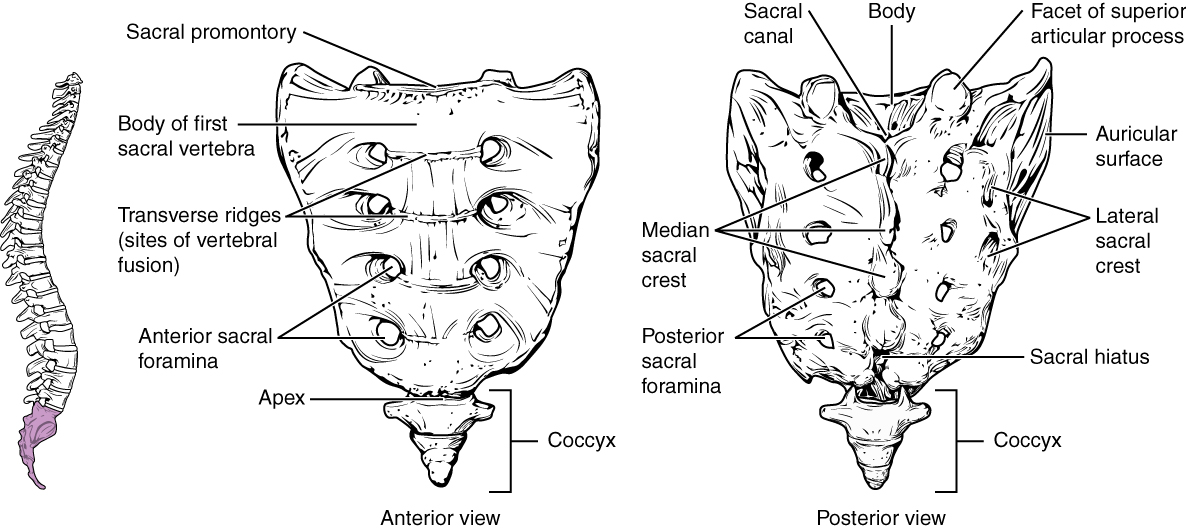
Intervertebral Discs and Ligaments of the Vertebral Column
The bodies of adjacent vertebrae are strongly anchored to each other by an intervertebral disc. This construction provides padding between the bones during weight begetting, and considering it can alter shape, also allows for motility between the vertebrae. Although the full corporeality of motion available between any two next vertebrae is small, when these movements are summed together along the entire length of the vertebral cavalcade, big body movements can be produced. Ligaments that extend along the length of the vertebral column also contribute to its overall back up and stability.
Intervertebral Disc
An intervertebral disc is a fibrocartilaginous pad that fills the gap betwixt adjacent vertebral bodies (run across (Figure)). Each disc is anchored to the bodies of its next vertebrae, thus strongly uniting these. The discs also provide padding between vertebrae during weight bearing. Because of this, intervertebral discs are thin in the cervical region and thickest in the lumbar region, which carries the about body weight. In total, the intervertebral discs business relationship for approximately 25 percentage of your trunk height between the top of the pelvis and the base of the skull. Intervertebral discs are as well flexible and can change shape to permit for movements of the vertebral cavalcade.
Each intervertebral disc consists of ii parts. The anulus fibrosus is the tough, fibrous outer layer of the disc. Information technology forms a circle (anulus = "ring" or "circumvolve") and is firmly anchored to the outer margins of the adjacent vertebral bodies. Within is the nucleus pulposus, consisting of a softer, more gel-like material. It has a high water content that serves to resist compression and thus is important for weight bearing. With increasing age, the water content of the nucleus pulposus gradually declines. This causes the disc to become thinner, decreasing total body height somewhat, and reduces the flexibility and range of motion of the disc, making bending more difficult.
The gel-like nature of the nucleus pulposus also allows the intervertebral disc to change shape as one vertebra rocks side to side or forward and back in relation to its neighbors during movements of the vertebral column. Thus, bending forward causes compression of the anterior portion of the disc only expansion of the posterior disc. If the posterior anulus fibrosus is weakened due to injury or increasing age, the pressure exerted on the disc when angle forward and lifting a heavy object can crusade the nucleus pulposus to protrude posteriorly through the anulus fibrosus, resulting in a herniated disc ("ruptured" or "slipped" disc) ((Figure)). The posterior bulging of the nucleus pulposus can cause compression of a spinal nerve at the indicate where it exits through the intervertebral foramen, with resulting pain and/or muscle weakness in those torso regions supplied past that nerve. The nigh common sites for disc herniation are the L4/L5 or L5/S1 intervertebral discs, which can cause sciatica, a widespread pain that radiates from the lower back down the thigh and into the leg. Similar injuries of the C5/C6 or C6/C7 intervertebral discs, following forcible hyperflexion of the cervix from a standoff accident or football injury, can produce hurting in the neck, shoulder, and upper limb.
Herniated Intervertebral Disc
Weakening of the anulus fibrosus tin result in herniation (protrusion) of the nucleus pulposus and compression of a spinal nerve, resulting in pain and/or muscle weakness in the body regions supplied by that nerve.

Watch this animation to see what it means to "slip" a disk. Lookout man this second animation to see ane possible treatment for a herniated disc, removing and replacing the damaged disc with an bogus one that allows for movement between the adjacent certebrae. How could lifting a heavy object produce pain in a lower limb?
Ligaments of the Vertebral Column
Side by side vertebrae are united by ligaments that run the length of the vertebral column along both its posterior and anterior aspects ((Figure)). These serve to resist excess forward or backward bending movements of the vertebral column, respectively.
The inductive longitudinal ligament runs down the inductive side of the entire vertebral column, uniting the vertebral bodies. It serves to resist backlog backward angle of the vertebral column. Protection against this movement is particularly important in the neck, where extreme posterior bending of the head and neck can stretch or tear this ligament, resulting in a painful whiplash injury. Prior to the mandatory installation of seat headrests, whiplash injuries were common for passengers involved in a rear-stop automobile standoff.
The supraspinous ligament is located on the posterior side of the vertebral column, where it interconnects the spinous processes of the thoracic and lumbar vertebrae. This potent ligament supports the vertebral column during forwards angle motions. In the posterior neck, where the cervical spinous processes are brusk, the supraspinous ligament expands to go the nuchal ligament (nuchae = "nape" or "dorsum of the neck"). The nuchal ligament is attached to the cervical barbed processes and extends upward and posteriorly to attach to the midline base of the skull, out to the external occipital protuberance. It supports the skull and prevents it from falling forward. This ligament is much larger and stronger in four-legged animals such as cows, where the large skull hangs off the front end end of the vertebral column. You can easily feel this ligament by showtime extending your head backward and pressing down on the posterior midline of your cervix. Then tilt your caput forward and you will fill up the nuchal ligament popping out as it tightens to limit anterior bending of the caput and neck.
Additional ligaments are located inside the vertebral culvert, next to the spinal string, forth the length of the vertebral column. The posterior longitudinal ligament is found anterior to the spinal cord, where it is attached to the posterior sides of the vertebral bodies. Posterior to the spinal cord is the ligamentum flavum ("yellow ligament"). This consists of a series of short, paired ligaments, each of which interconnects the lamina regions of adjacent vertebrae. The ligamentum flavum has large numbers of rubberband fibers, which have a yellow color, allowing information technology to stretch then pull dorsum. Both of these ligaments provide important support for the vertebral column when angle forward.
Ligaments of Vertebral Cavalcade
The anterior longitudinal ligament runs the length of the vertebral column, uniting the inductive sides of the vertebral bodies. The supraspinous ligament connects the barbed processes of the thoracic and lumbar vertebrae. In the posterior cervix, the supraspinous ligament enlarges to form the nuchal ligament, which attaches to the cervical spinous processes and to the base of the skull.
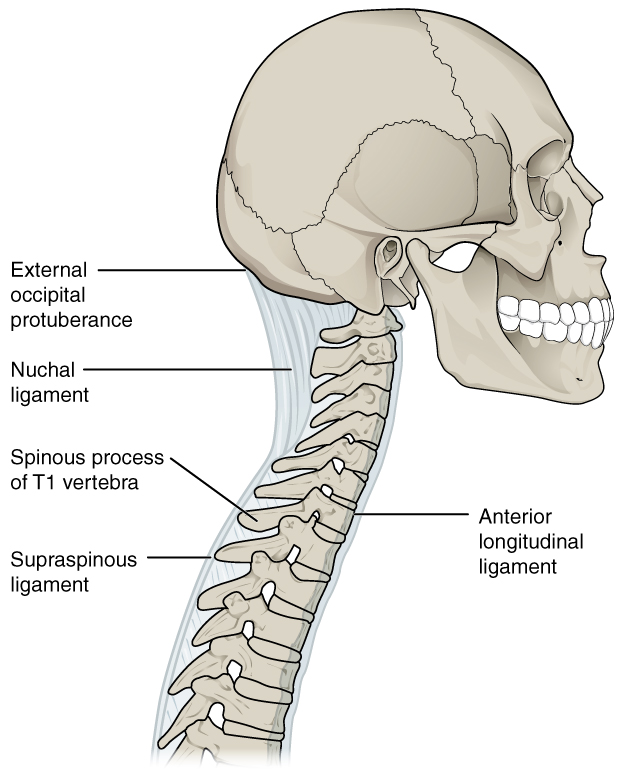
Utilize this tool to identify the bones, intervertebral discs, and ligaments of the vertebral column. The thickest portions of the inductive longitudinal ligament and the supraspinous ligament are found in which regions of the vertebral cavalcade?
Career Connections
Chiropractor Chiropractors are health professionals who use nonsurgical techniques to help patients with musculoskeletal organization problems that involve the basic, muscles, ligaments, tendons, or nervous system. They care for problems such every bit neck pain, dorsum hurting, joint pain, or headaches. Chiropractors focus on the patient's overall health and can besides provide counseling related to lifestyle issues, such as nutrition, practise, or sleep issues. If needed, they will refer the patient to other medical specialists.
Chiropractors use a drug-gratuitous, hands-on arroyo for patient diagnosis and treatment. They will perform a physical test, assess the patient's posture and spine, and may perform boosted diagnostic tests, including taking X-ray images. They primarily use manual techniques, such as spinal manipulation, to adjust the patient's spine or other joints. They tin recommend therapeutic or rehabilitative exercises, and some as well include acupuncture, massage therapy, or ultrasound as part of the treatment program. In addition to those in general practice, some chiropractors specialize in sport injuries, neurology, orthopaedics, pediatrics, nutrition, internal disorders, or diagnostic imaging.
To become a chiropractor, students must have 3–iv years of undergraduate education, nourish an accredited, four-twelvemonth Md of Chiropractic (D.C.) caste program, and pass a licensure examination to be licensed for do in their country. With the aging of the babe-blast generation, employment for chiropractors is expected to increase.
Chapter Review
The vertebral column forms the cervix and back. The vertebral column originally develops every bit 33 vertebrae, but is eventually reduced to 24 vertebrae, plus the sacrum and coccyx. The vertebrae are divided into the cervical region (C1–C7 vertebrae), the thoracic region (T1–T12 vertebrae), and the lumbar region (L1–L5 vertebrae). The sacrum arises from the fusion of five sacral vertebrae and the coccyx from the fusion of four pocket-sized coccygeal vertebrae. The vertebral column has 4 curvatures, the cervical, thoracic, lumbar, and sacrococcygeal curves. The thoracic and sacrococcygeal curves are principal curves retained from the original fetal curvature. The cervical and lumbar curves develop after birth and thus are secondary curves. The cervical curve develops as the babe begins to hold up the head, and the lumbar curve appears with standing and walking.
A typical vertebra consists of an enlarged anterior portion chosen the torso, which provides weight-bearing support. Attached posteriorly to the torso is a vertebral curvation, which surrounds and defines the vertebral foramen for passage of the spinal cord. The vertebral arch consists of the pedicles, which adhere to the vertebral trunk, and the laminae, which come together to form the roof of the arch. Arising from the vertebral arch are the laterally projecting transverse processes and the posteriorly oriented spinous process. The superior articular processes project upward, where they articulate with the downward projecting junior articular processes of the next higher vertebrae.
A typical cervical vertebra has a small trunk, a bifid (Y-shaped) spinous process, and U-shaped transverse processes with a transverse foramen. In addition to these characteristics, the axis (C2 vertebra) also has the dens projecting upwardly from the vertebral body. The atlas (C1 vertebra) differs from the other cervical vertebrae in that it does not have a body, but instead consists of bony ring formed by the inductive and posterior arches. The atlas articulates with the dens from the axis. A typical thoracic vertebra is distinguished by its long, downwardly projecting spinous process. Thoracic vertebrae also have articulation facets on the trunk and transverse processes for attachment of the ribs. Lumbar vertebrae support the greatest amount of torso weight and thus have a big, thick torso. They as well accept a short, blunt spinous process. The sacrum is triangular in shape. The median sacral crest is formed by the fused vertebral spinous processes and the lateral sacral crest is derived from the fused transverse processes. Inductive (ventral) and posterior (dorsal) sacral foramina allow branches of the sacral spinal nerves to exit the sacrum. The auricular surfaces are articulation sites on the lateral sacrum that anchor the sacrum to the hipbones to form the pelvis. The coccyx is small and derived from the fusion of four small vertebrae.
The intervertebral discs fill in the gaps betwixt the bodies of adjacent vertebrae. They provide stiff attachments and padding between the vertebrae. The outer, fibrous layer of a disc is chosen the anulus fibrosus. The gel-like interior is called the nucleus pulposus. The disc can change shape to allow for movement between vertebrae. If the anulus fibrosus is weakened or damaged, the nucleus pulposus tin protrude outward, resulting in a herniated disc.
The anterior longitudinal ligament runs along the total length of the anterior vertebral cavalcade, uniting the vertebral bodies. The supraspinous ligament is located posteriorly and interconnects the spinous processes of the thoracic and lumbar vertebrae. In the neck, this ligament expands to go the nuchal ligament. The nuchal ligament is attached to the cervical spinous processes and superiorly to the base of operations of the skull, out to the external occipital protuberance. The posterior longitudinal ligament runs within the vertebral culvert and unites the posterior sides of the vertebral bodies. The ligamentum flavum unites the lamina of adjacent vertebrae.
Interactive Link Questions
Osteoporosis is a common age-related os disease in which os density and strength is decreased. Watch this video to get a better understanding of how thoracic vertebrae may get weakened and may fractured due to this disease. How may vertebral osteoporosis contribute to kyphosis?
Osteoporosis causes thinning and weakening of the vertebral bodies. When this occurs in thoracic vertebrae, the bodies may collapse producing kyphosis, an enhanced anterior curvature of the thoracic vertebral column.
Sentry this animation to see what it means to "slip" a disk. Sentry this 2nd blitheness to see 1 possible treatment for a herniated disc, removing and replacing the damaged disc with an artificial i that allows for movement between the next certebrae. How could lifting a heavy object produce pain in a lower limb?
Lifting a heavy object tin can cause an intervertebral disc in the lower back to bulge and compress a spinal nerve equally it exits through the intervertebral foramen, thus producing pain in those regions of the lower limb supplied by that nerve.
Utilize this tool to identify the bones, intervertebral discs, and ligaments of the vertebral column. The thickest portions of the anterior longitudinal ligament and the supraspinous ligament are plant in which regions of the vertebral column?
The inductive longitudinal ligament is thickest in the thoracic region of the vertebral column, while the supraspinous ligament is thickest in the lumbar region.
Review Questions
The cervical region of the vertebral column consists of ________.
- 7 vertebrae
- 12 vertebrae
- 5 vertebrae
- a single bone derived from the fusion of five vertebrae
The primary curvatures of the vertebral cavalcade ________.
- include the lumbar curve
- are remnants of the original fetal curvature
- include the cervical curve
- develop after the time of birth
A typical vertebra has ________.
- a vertebral foramen that passes through the body
- a superior articular process that projects down to articulate with the superior portion of the next lower vertebra
- lamina that spans between the transverse process and spinous process
- a pair of laterally projecting barbed processes
A typical lumbar vertebra has ________.
- a curt, rounded spinous procedure
- a bifid barbed process
- articulation sites for ribs
- a transverse foramen
Which is institute only in the cervical region of the vertebral column?
- nuchal ligament
- ligamentum flavum
- supraspinous ligament
- anterior longitudinal ligament
Critical Thinking Questions
Draw the vertebral column and ascertain each region.
Answer: The adult vertebral column consists of 24 vertebrae, plus the sacrum and coccyx. The vertebrae are subdivided into cervical, thoracic, and lumbar regions. At that place are seven cervical vertebrae (C1–C7), 12 thoracic vertebrae (T1–T12), and five lumbar vertebrae (L1–L5). The sacrum is derived from the fusion of five sacral vertebrae and the coccyx is formed by the fusion of four modest coccygeal vertebrae.
Depict a typical vertebra.
A typical vertebra consists of an inductive torso and a posterior vertebral arch. The body serves for weight bearing. The vertebral arch surrounds and protects the spinal cord. The vertebral arch is formed by the pedicles, which are fastened to the posterior side of the vertebral body, and the lamina, which come together to class the top of the curvation. A pair of transverse processes extends laterally from the vertebral arch, at the junction between each pedicle and lamina. The barbed procedure extends posteriorly from the summit of the curvation. A pair of superior articular processes projection upwardly and a pair of junior articular processes project downward. Together, the notches plant in the margins of the pedicles of adjacent vertebrae form an intervertebral foramen.
Describe the sacrum.
The sacrum is a unmarried, triangular-shaped bone formed by the fusion of 5 sacral vertebrae. On the posterior sacrum, the median sacral crest is derived from the fused spinous processes, and the lateral sacral crest results from the fused transverse processes. The sacral culvert contains the sacral spinal fretfulness, which exit via the inductive (ventral) and posterior (dorsal) sacral foramina. The sacral promontory is the anterior lip. The sacrum besides forms the posterior portion of the pelvis.
Describe the structure and function of an intervertebral disc.
An intervertebral disc fills in the space betwixt adjacent vertebrae, where it provides padding and weight-begetting power, and allows for movements between the vertebrae. It consists of an outer anulus fibrosus and an inner nucleus pulposus. The anulus fibrosus strongly anchors the adjacent vertebrae to each other, and the high water content of the nucleus pulposus resists compression for weight bearing and tin change shape to let for vertebral column movements.
Define the ligaments of the vertebral column.
The anterior longitudinal ligament is attached to the vertebral bodies on the inductive side of the vertebral column. The supraspinous ligament is located on the posterior side, where information technology interconnects the thoracic and lumbar spinous processes. In the posterior neck, this ligament expands to become the nuchal ligament, which attaches to the cervical barbed processes and the base of the skull. The posterior longitudinal ligament and ligamentum flavum are located inside the vertebral culvert. The posterior longitudinal ligament unites the posterior sides of the vertebral bodies. The ligamentum flavum unites the lamina of adjacent vertebrae.
Glossary
- anterior arch
- inductive portion of the band-like C1 (atlas) vertebra
- inductive longitudinal ligament
- ligament that runs the length of the vertebral cavalcade, uniting the inductive aspects of the vertebral bodies
- anterior (ventral) sacral foramen
- ane of the series of paired openings located on the anterior (ventral) side of the sacrum
- anulus fibrosus
- tough, gristly outer portion of an intervertebral disc, which is strongly anchored to the bodies of the adjacent vertebrae
- atlas
- first cervical (C1) vertebra
- centrality
- second cervical (C2) vertebra
- cervical curve
- posteriorly concave curvature of the cervical vertebral cavalcade region; a secondary curve of the vertebral column
- cervical vertebrae
- seven vertebrae numbered as C1–C7 that are located in the neck region of the vertebral column
- costal facet
- site on the lateral sides of a thoracic vertebra for joint with the head of a rib
- dens
- bony project (odontoid process) that extends up from the trunk of the C2 (axis) vertebra
- facet
- pocket-sized, flattened surface area on a bone for an articulation (joint) with another os, or for muscle attachment
- inferior articular process
- bony process that extends downward from the vertebral arch of a vertebra that articulates with the superior articular process of the next lower vertebra
- intervertebral disc
- structure located between the bodies of next vertebrae that strongly joins the vertebrae; provides padding, weight begetting ability, and enables vertebral column movements
- intervertebral foramen
- opening located between next vertebrae for leave of a spinal nervus
- kyphosis
- (likewise, humpback or hunchback) excessive posterior curvature of the thoracic vertebral cavalcade region
- lamina
- portion of the vertebral curvation on each vertebra that extends between the transverse and spinous procedure
- lateral sacral crest
- paired irregular ridges running down the lateral sides of the posterior sacrum that was formed by the fusion of the transverse processes from the five sacral vertebrae
- ligamentum flavum
- series of brusque ligaments that unite the lamina of next vertebrae
- lordosis
- (also, swayback) excessive anterior curvature of the lumbar vertebral column region
- lumbar curve
- posteriorly concave curvature of the lumbar vertebral column region; a secondary bend of the vertebral column
- lumbar vertebrae
- five vertebrae numbered equally L1–L5 that are located in lumbar region (lower dorsum) of the vertebral column
- median sacral crest
- irregular ridge running downwardly the midline of the posterior sacrum that was formed from the fusion of the spinous processes of the five sacral vertebrae
- nuchal ligament
- expanded portion of the supraspinous ligament within the posterior cervix; interconnects the spinous processes of the cervical vertebrae and attaches to the base of the skull
- nucleus pulposus
- gel-like central region of an intervertebral disc; provides for padding, weight-bearing, and movement betwixt next vertebrae
- pedicle
- portion of the vertebral curvation that extends from the vertebral body to the transverse process
- posterior arch
- posterior portion of the band-similar C1 (atlas) vertebra
- posterior longitudinal ligament
- ligament that runs the length of the vertebral column, uniting the posterior sides of the vertebral bodies
- posterior (dorsal) sacral foramen
- one of the series of paired openings located on the posterior (dorsal) side of the sacrum
- chief curve
- anteriorly concave curvatures of the thoracic and sacrococcygeal regions that are retained from the original fetal curvature of the vertebral column
- sacral culvert
- bony tunnel that runs through the sacrum
- sacral foramina
- series of paired openings for nerve exit located on both the inductive (ventral) and posterior (dorsal) aspects of the sacrum
- sacral hiatus
- junior opening and termination of the sacral culvert
- sacral promontory
- inductive lip of the base (superior end) of the sacrum
- sacrococcygeal curve
- anteriorly concave curvature formed by the sacrum and coccyx; a primary bend of the vertebral column
- scoliosis
- abnormal lateral curvature of the vertebral column
- secondary curve
- posteriorly concave curvatures of the cervical and lumbar regions of the vertebral cavalcade that develop later the time of birth
- spinous process
- unpaired bony process that extends posteriorly from the vertebral arch of a vertebra
- superior articular process
- bony procedure that extends upwardly from the vertebral arch of a vertebra that articulates with the inferior articular procedure of the adjacent higher vertebra
- superior articular process of the sacrum
- paired processes that extend upward from the sacrum to articulate (join) with the inferior articular processes from the L5 vertebra
- supraspinous ligament
- ligament that interconnects the spinous processes of the thoracic and lumbar vertebrae
- thoracic curve
- anteriorly concave curvature of the thoracic vertebral cavalcade region; a principal bend of the vertebral column
- thoracic vertebrae
- twelve vertebrae numbered as T1–T12 that are located in the thoracic region (upper dorsum) of the vertebral column
- transverse foramen
- opening constitute only in the transverse processes of cervical vertebrae
- transverse procedure
- paired bony processes that extends laterally from the vertebral curvation of a vertebra
- vertebral arch
- bony arch formed by the posterior portion of each vertebra that surrounds and protects the spinal cord
- vertebral (spinal) canal
- bony passageway within the vertebral cavalcade for the spinal cord that is formed past the series of individual vertebral foramina
- vertebral foramen
- opening associated with each vertebra divers past the vertebral curvation that provides passage for the spinal cord
Source: https://opentextbc.ca/anatomyandphysiologyopenstax/chapter/the-vertebral-column/
0 Response to "What Region of the Vertebral Column Does This Vertebra Belong to?"
Post a Comment